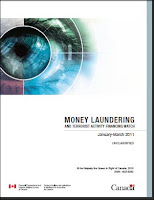The Honourable Jim Flaherty, Minister of Finance, has launched a consultation aimed at updating Canada’s regime for combating money laundering and terrorist financing. The consultation paper, “Strengthening Canada’s Anti-Money Laundering and Anti‑Terrorist Financing Regime,” puts forward several proposals that may be considered for future changes to the Proceeds of Crime (Money Laundering) and Terrorist Financing Act.
The proposals in the paper are organized around the following key areas:
· strengthening client due diligence standards;
· closing gaps in Canada’s regime;
· improving compliance, monitoring and enforcement;
· strengthening information sharing in the regime;
· introducing a list of potential countermeasures; and
· updating reporting requirements.
The paper will also serve to inform the Parliamentary review of the Proceeds of Crime (Money Laundering) and Terrorist Financing Act that will be conducted in 2012 by the Standing Senate Committee on Banking, Trade and Commerce. The deadline for comments is March 1, 2012.
























